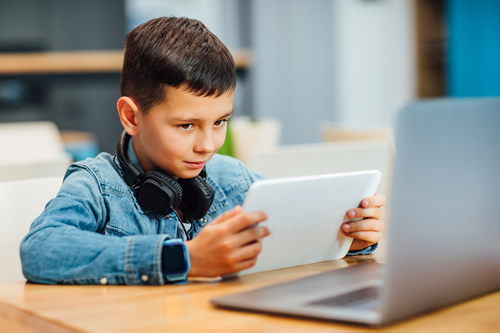Culturally responsive teaching before COVID-19 and after should focus on keeping students’ cultural norms and beliefs in mind and putting time into relating to students who have different life experiences, languages, and values than your own. Being culturally responsive requires a reflection on your own life experiences and how they’ve impacted your belief systems.
Put simply, once we consider the experiences that have shaped us, we can appreciate that despite our differences, we are more alike than we think.
Tackling the overwhelm
When working with teachers with English-language learners, I find that many of them are overwhelmed by language barriers.
Related content: How we turned around our ELL program
As a result, they have difficulty developing a personal rapport with these students. “I don’t speak their language,” they’ll tell me, or “My ELL students don’t have the English language skills yet to ask me questions or respond during classroom conversations.”
While language barriers can be challenging, especially when a teacher has 85 to 100 students, diversity in the classroom benefits students and teachers alike with opportunities to learn about each other’s culture and heritage. My answer to them is always: Let’s find ways to bridge these differences.
Here are eight ways to make that happen:
1. Start small. Begin by bridging the gaps with basic gestures to establish a welcoming classroom environment for all students and providing them with a sense of wellbeing that promotes academic and social success. For starters, always learn how to pronounce your students’ names and greet them with a smile. A smile goes a long way even when you feel like a student might not understand your words.
2. Connect with parents and guardians. One great way to connect with your EL students is to build a relationship with their parents or guardians. When the whole family understands what’s being covered in class, it can help relieve anxiety about a new school and learning a new language. We like sharing StudySync’s Language Support Summaries for texts and/or for Spanish-speaking families. And, Spanish-language Blasts can be printed out and sent home with EL students and prompts them to share their reading experiences with their families.
3. Address basic needs first. Depending on the situations of the multilingual learner, it is important to focus on Maslow’s Needs being met first. Many students may be in different immigration circumstances and feel ineligible to participate in food programs, food insecurities, and so forth. Without basic needs being met, it will be hard for them to focus on distance learning.
4. Make sure computers and WiFi are available. One without the other leaves students, families and teachers feeling a huge sense of inequity and frustration. When students have viable tools at home with them, but do not have internet services, you hear voices call and say, “I’m ready to learn, but I don’t have Internet services.” This is devastating on both ends of the phone line.
5. Use tools/platforms that students are familiar with. Use tools that they’ve already been using in school. If they were doing it pre-pandemic, teachers should begin making use of digital platforms to meet students ever-changing learning needs. When students can maneuver easily through programs and platforms that they are familiar with, they can get started right away with distance learning, and pick up right where they left off.
6. Organize assignments and announcements/information. Make things easy for students to navigate on Google Classroom or whatever platform you may be using. To keep students engaged in online lessons, I’ve taught myself how to use online whiteboard tools for myself and students, I made wheels that spin for students to answer questions and added in their pictures on wheeloffaces.com, which they love. Interactive vocabulary games are a winner, since I also teach math. I’ve used wordwall.org and it’s been a hit. Multilingual learners can’t spend too much time on Zoom or Google Hangouts all day; they need some independent learning time.
7. Bring the culture. Another way to help build relationships with parents or guardians is to ask students to share their family’s culture with their classroom peers and provide learning opportunities for all students. Oral storytelling is often an important part of someone’s cultural background. If possible, invite students’ parents and/or guardians into the classroom to share something unique or important about their culture. Students can join alongside their parents/guardians and tell their unique story or share cultural heirlooms with other students. If it’s easier, have students share photos or videos or create a poster to share information.
8. Advocate for peer-to-peer learning. Students learn from their teachers, but they also learn from one another. We use also use StudySync’s TV, SkillsTV, and Concept Definition videos, which depict a range of cultures that help students “envision” themselves engaging in academic conversations with their peers. Students can watch the videos with the closed captioning enabled or with the use of the video transcript, and then they can practice their listening skills while following along with the text from the video.
Combined, these strategies will all go a long way in helping teachers develop a culturally responsible instructional approach that bridges common gaps that can keep English-language learners from realizing their full potential in the educational environment.
- The evolving requirements of a K-12 school network - April 24, 2024
- A bungled FAFSA rollout threatens students’ college ambitions - April 24, 2024
- How digital tools and AI can enhance social studies - April 23, 2024

